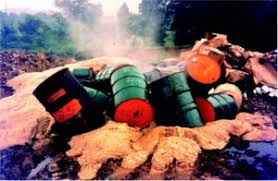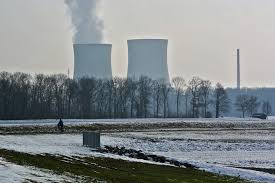Hazardous Wastes, solid, liquid, or gas wastes can cause death, illness, or injury to people or destruction of the environment if improperly treated, stored, transported, or discarded.
Substances are considered hazardous wastes if they are ignitable (capable of burning or causing a fire), corrosive (able to corrode steel or harm organisms because of extreme acidic or basic properties), reactive(able to explode or produce toxic cyanide or sulfide gas), or toxic (containing substances that are poisonous). Mixtures, residues, or materials containing hazardous wastes are also considered hazardous wastes.
Sources of Hazardous Wastes
1. Industrial Activities
Hazardous wastes are generated by nearly every industry; those industries that themselves generate few hazardous wastes nonetheless use products from hazardous waste generating industries.
For example, in the computer software industry, writing software generates little hazardous waste, but the manufacture of computers involves many industrial processes.
Making a computer circuit board generate spent electroplating baths that contains metal salts, and the production of computer chips uses acids, other caustic chemicals, and solvents.
Other hazardous wastes are generated in the manufacture of fiber optics and copper wire used in electronic transmission, as well as magnetic disks, paper for technical manuals, photographs for packaging and publicity, and trucks for transportation of the finished product.
2. Agricultural Activities
Industry is not alone in generating hazardous wastes. Agriculture produces such wastes as pesticides and herbicides and the materials used in their application. Fluoride wastes are by-products of phosphate fertilizer production.
Read Also : The Application of Biotechnology to Waste Management
Even soluble nitrates from manure may dissolve into groundwater and contaminate drinking-water wells; high levels of nitrates may cause health problems.
3. Household Activities
Household sources of hazardous wastes include toxic paints, flammable solvents, caustic cleaners, toxic batteries, pesticides, drugs, and mercury from broken fever thermometers.
Local waste- disposal systems may refuse these items. If they are accepted, careful monitoring may be required to make sure soil or groundwater is not contaminated. The householder may be asked to recycle or dispose of these items separately.
Renovations of older homes may cause toxic lead paint to flake off from walls. Insulation materials on furnace pipes may contain asbestos particles, which can break off and hang suspended in air; when inhaled, they can cause lung disease and cancer.
4. Medical Sources
Hospitals use special care in disposing of wastes contaminated with blood and tissue, separating these hazardous wastes from ordinary waste. Hospitals and doctors’ offices must be especially careful with needles, scalpels, and glassware, called “sharps.”
Pharmacies discard outdated and unused drugs; testing laboratories disposal of chemical wastes. Medicine also makes use of significant amounts of radioactive isotopes for diagnosis and treatment, and these substances must be tracked and disposed of carefully.
Effects of Hazardous Wastes
Hazardous wastes may pollute soil, air, surface water, or underground water. Pollution of soil may affect people who live on it, plants that put roots into it, and animals that move over it.
Sludge from municipal sewage disposal may contain toxic elements if industrial waste is mixed with domestic sewage. If the sludge is used as a fertilizer, these elements may contaminate fields.
Toxic substances that do not break down or bind tightly to the soil may be taken up by growing plants; the toxic substances may later appear in animals that eat crops grown there and possibly in people who feed also on the crop or even on the animals that feeds from there.
Air may become contaminated by direct emission of hazardous wastes. Evaporation of toxic solvents from paints and cleaning agents is a common problem. The air above hazardous waste may become dangerously contaminated by escaping gas, as can occur in houses built on mine tailings or old dump sites.

Basements of homes built over uranium mine tailings often contain high levels of radioactive radon gas escaping from the radioactivity below.
Rivers and lake pollution, if it is toxic enough, may kill animals and plant life immediately, or it may injure them slowly. For example, fluoride concentrates in teeth and bone, and too much fluoride in water may cause dental and bone problems.
Compounds such as dichlorodiphenyltrichloroethane (DDT), PCBs, and dioxins are more soluble in fats than in water and therefore tend to build up in the fats within plants and animals.
These substances may be present in very low concentrations in water but accumulate to higher concentrations within algae and insects, and build up to even higher levels in fishes.
Birds or people that feed on these fishes are then exposed to very high levels of hazardous substances. In birds, these substances can interfere with egg production and bone formation.
Even pollution that is not toxic can kill: Phosphates and nitrates, usually harmless, can fertilize the algae that grow in lakes or rivers. When algae grows, in the presence of sunlight, they produce oxygen.
But if algae grow too much or too fast, they consume great amounts of oxygen, both when the sun is not shining and when the algae dies and begins to decay. Lack of oxygen eventually suffocates other life; some living things may be poisoned by toxins contained in the algae.
This process of algal overgrowth, called eutrophication, can kill life in lakes and rivers. In some cases, particular algae can also poison the drinking water humans and livestock.
Underground pollutants can be carried by underground water flow: These wastes form underground plumes (long, featherlike columns) of contaminants, which may reach the surface if the water emerges in a spring or is pumped from wells.
Especially dangerous are solvents that may have leaked from underground storage tanks or may have been carelessly poured on the ground. Toxic metal ions may also be present in these waste plumes.
Hazardous-Waste Control Measures
1. Source Reduction
The best way to eliminate hazardous wastes is not to generate them in the first place. For example, improvements have been made in the production of integrated circuits: The toxic chlorinated hydrocarbons commonly used in the 1970s were replaced in the 1980s by less toxic glycol ethers and in the 1990s by low-toxicity esters and alcohols.
2. Recycling
Recycling is the recovery of usable materials from waste, for example; approximately 15 percent of sulfuric acid is recycled in chemical manufacturing. In the past, most sulfur used for sulfuric acid production was mined; now the amount of sulfur recovered from smelters (facilities that remove metals from ores), refineries (facilities that purify substances), and manufacturers is more than double that produced by mining.
3. Treatment
Wastes may be made less hazardous by physical, chemical, or biological treatment. For example, sodium hydroxide has been used to treat acid wastes at integrated-circuit plants.
Sulfuric acid wastes, if not recycled, can be treated with ammonia wastes from the same plant, forming ammonium sulfate, a fertilizer.
Incineration has been used since human beings learned to control fire. It is the preferred method of handling infectious medical wastes. Solidification of wastes involves melting them and mixing them with a binder, a substance that eventually hardens the mix into an impenetrable mass.
4. Disposal
Surface impoundment(placing liquid or semi liquid wastes in unlined pits) keeps waste in long-term storage, but it is not considered a method of final disposal. About 8 percent of hazardous waste is injected into deep wells; 21 percent enters landfills (large, unlined pits into which solid wastes are placed) as its ultimate resting place.
In summary,many dangerous substances can be used only with special precautions that decrease their risks. When discarded, these substances are no longer under the direct control of the user and may pose special hazards to people or other organisms that come in contact with them. Because of such potential risks, hazardous wastes are processed separately from ordinary wastes.
Hazardous Wastes can cause death, illness, or injury to people or destruction of the environment if improperly treated, stored, transported, or discarded.
Hazardous wastes are generated by nearly every industry. Household sources of hazardous wastes include toxic paints, flammable solvents, caustic cleaners, toxic batteries, pesticides, drugs, and mercury from broken fever thermometers.
Read Also : Recycling as a Method of Environmental Pollution Control
Hospitals use special care in disposing of wastes contaminated with blood and tissue, separating these hazardous wastes from ordinary waste. Hazardous wastes may pollute soil, air, surface water, or underground water.
River and lake pollution, if it is toxic enough, may kill animal and plant life immediately, or it may injure them slowly. The process of algal overgrowth, called eutrophication, can kill life in lakes and rivers.
The best way to eliminate hazardous wastes is not to generate them in the first place. Recycling is the recovery or reuse of usable materials from waste. Wastes may be made less hazardous by physical, chemical, or biological treatment.

